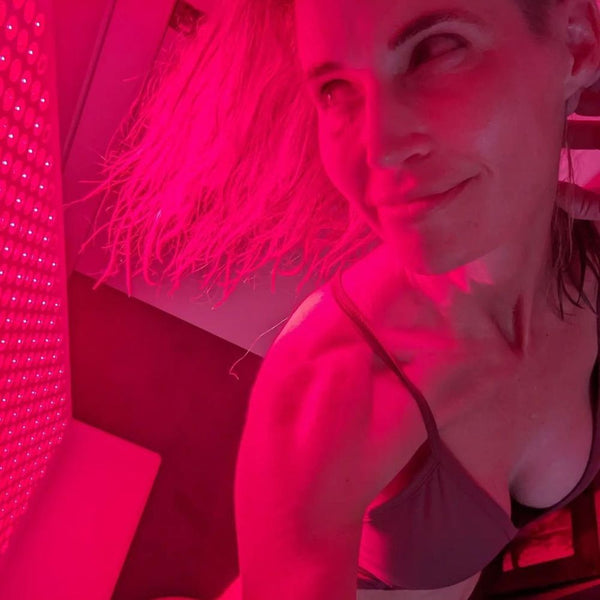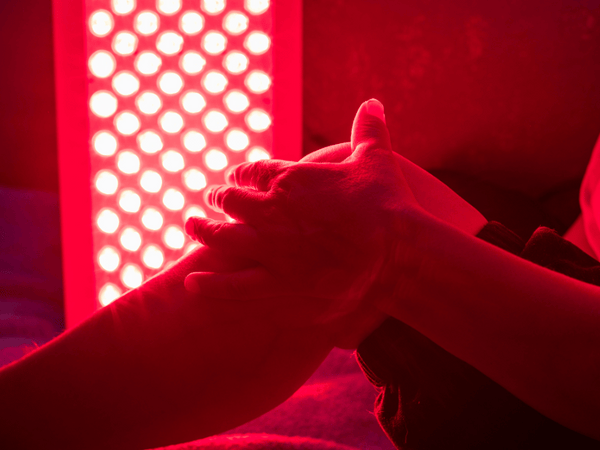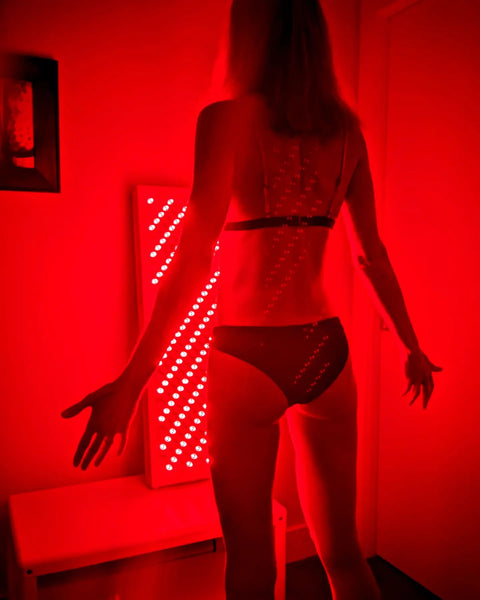
Enhancing Athletic Performance with Red Light Therapy
Enhancing Athletic Performance with Red Light Therapy
Athletic performance is a key focus for many individuals, from professional athletes to fitness enthusiasts. In the quest to enhance performance, improve recovery, and prevent injuries, various methods and technologies have emerged. One such innovative approach is red light therapy. This non-invasive treatment has gained attention for its potential to support and improve athletic performance through various physiological benefits.
In this comprehensive guide, we will delve into the science behind red light therapy, explore its benefits for athletes, review scientific evidence, and provide practical advice on how to incorporate it into your training routine. Whether you're an elite athlete or someone looking to optimize your workouts, understanding red light therapy could be a game-changer in achieving your performance goals.
What is Red Light Therapy?
Definition and Basic Principles
Red light therapy (RLT), also known as low-level laser therapy (LLLT) or photobiomodulation, involves the use of specific wavelengths of light to penetrate the skin and stimulate cellular processes. This therapy utilizes red and near-infrared light, typically in the wavelength range of 600 to 1000 nanometers, to target cells and tissues at a deep level.
History and Development
The origins of red light therapy can be traced back to the late 19th century when Danish physician Niels Ryberg Finsen first used light therapy to treat lupus vulgaris, a form of tuberculosis affecting the skin. Over the years, the technology has evolved, and modern red light therapy now benefits from advancements in LED technology, making it more accessible and effective.
How Red Light Therapy Works
At the cellular level, red light therapy primarily targets the mitochondria, the powerhouses of cells. The light energy absorbed by the mitochondria enhances their function, leading to increased production of adenosine triphosphate (ATP), the molecule that carries energy within cells. This boost in ATP production supports various cellular processes, including repair, regeneration, and reduced inflammation.
- Cellular Energy Boost: By increasing ATP production, cells have more energy to perform their functions effectively.
- Enhanced Blood Flow: Red light therapy promotes vasodilation, improving blood circulation and oxygen delivery to tissues.
- Reduced Oxidative Stress: The therapy helps in neutralizing free radicals, reducing oxidative stress, and preventing cellular damage.
The combination of these effects makes red light therapy a powerful tool for enhancing overall cellular health and function, which translates to numerous benefits for athletes.
Benefits of Red Light Therapy for Athletes
Red light therapy offers a wide range of benefits specifically tailored to the needs of athletes. These benefits can help improve exercise performance, speed up recovery, and reduce the risk of injury. Let's explore some of the key advantages.
Improved Muscle Recovery
One of the most significant benefits of red light therapy for athletes is its ability to enhance muscle recovery. After intense workouts, muscles need time to repair and rebuild. Red light therapy accelerates this process by:
- Increasing ATP Production: Enhanced cellular energy helps muscles recover faster.
- Reducing Inflammation: By decreasing inflammatory markers, red light therapy reduces delayed onset muscle soreness and stiffness.
- Promoting Protein Synthesis: This helps in the repair and growth of muscle tissues.
Enhanced Endurance and Strength
Athletes can experience improvements in both endurance and strength with regular red light therapy sessions. The therapy aids in:
- Boosting Mitochondrial Function: Improved mitochondrial health leads to better endurance as muscles can sustain prolonged activity.
- Increasing Oxygen Utilization: Enhanced blood flow and oxygen delivery improve muscle performance and delay fatigue.
Reduced Inflammation and Pain
Inflammation and pain are common issues for athletes, particularly after intense training sessions or competitions. Red light therapy helps mitigate these problems through:
- Anti-inflammatory Effects: The therapy reduces cytokine levels, which are involved in inflammation.
- Pain Relief: By promoting the release of endorphins and other pain-relieving substances, red light therapy can alleviate both acute and chronic pain.
Accelerated Healing of Injuries
Injuries are an inevitable part of any athlete's journey. Red light therapy can play a crucial role in speeding up the healing process for various types of injuries, including:
- Soft Tissue Injuries: Such as sprains and strains, by enhancing cellular repair mechanisms.
- Bone Injuries: By stimulating bone cell activity and improving blood flow to the injured area.
- Wound Healing: Accelerates the healing of cuts, bruises, and other surface wounds.
Improved Sleep and Energy Levels
Quality sleep and high energy levels are vital for peak athletic performance. Red light therapy can positively influence these aspects by:
- Regulating Circadian Rhythms: Exposure to red light can help reset the body's internal clock, leading to better sleep patterns.
- Boosting Melatonin Production: This helps in achieving deeper, more restful sleep.
- Increasing Daytime Energy: Improved sleep quality translates to higher energy levels and better performance during training and competitions.
Summary of Benefits of Red Light Therapy for Athletes
| Benefit | Description |
|---|
| Improved Muscle Recovery | Faster repair and reduced soreness |
| Enhanced Endurance and Strength | Better oxygen utilization and prolonged muscle activity |
| Reduced Inflammation and Pain | Lower cytokine levels and natural pain relief |
| Accelerated Healing of Injuries | Faster recovery from soft tissue, bone, and wound injuries |
| Improved Sleep and Energy Levels | Better sleep patterns and increased daytime energy |
How Red Light Therapy Enhances Athletic Performance
Red light therapy is an innovative approach that can significantly enhance athletic performance through various physiological and cellular mechanisms. This section will delve into the specific ways red light therapy boosts performance, focusing on muscle recovery, endurance, injury prevention, and inflammation reduction.
Detailed Look at Muscle Recovery and Repair
Muscle recovery is a crucial aspect of any athlete's training regimen. Red light therapy enhances muscle recovery by:
- Increasing ATP Production: As previously mentioned, the therapy boosts ATP production in cells, providing more energy for muscle repair and growth.
- Enhancing Blood Flow: Improved blood circulation ensures that muscles receive more oxygen and nutrients, speeding up the recovery process.
- Reducing Muscle Damage: Red light therapy reduces oxidative stress and inflammation, minimizing muscle damage and promoting faster healing.
Effects on Endurance and Fatigue
Endurance and the ability to sustain prolonged physical activity are vital for athletes. Red light therapy positively impacts these areas by:
- Improving Mitochondrial Function: Enhanced mitochondrial activity means more efficient energy production, leading to better endurance.
- Delaying Onset of Fatigue: With improved oxygen utilization and reduced oxidative stress, athletes can train harder and longer before experiencing fatigue.
- Boosting Aerobic Capacity: Studies have shown that red light therapy can improve aerobic capacity, allowing athletes to perform at higher intensities for longer periods.
Impact on Injury Prevention and Treatment
Injuries can derail an athlete's progress, but red light therapy can help in both preventing and treating injuries:
- Strengthening Tissues: By promoting collagen production, red light therapy strengthens tendons and ligaments, reducing the risk of injury.
- Accelerating Healing: For existing injuries, red light therapy accelerates the healing process by enhancing cellular repair mechanisms and reducing inflammation.
- Reducing Scar Tissue Formation: The therapy can help minimize scar tissue formation, leading to more complete and functional recovery.
Role in Reducing Inflammation and Soreness
Inflammation and soreness are common after intense physical activity. Red light therapy aids in mitigating these issues through:
- Anti-inflammatory Properties: The therapy reduces the production of pro-inflammatory cytokines, leading to decreased inflammation.
- Pain Relief: By promoting the release of endorphins and other pain-relieving substances, red light therapy helps in reducing both acute and chronic pain.
- Enhanced Muscle Relaxation: Improved blood flow and reduced inflammation contribute to overall muscle relaxation and reduced soreness.
Comparing Red Light Therapy to Other Recovery Methods
Athletes have a variety of recovery methods at their disposal, each with its own set of benefits and drawbacks. In this section, we'll compare red light therapy with traditional recovery methods such as ice baths, compression therapy, and massage, highlighting the advantages and disadvantages of each.
Traditional Recovery Methods
Ice Baths
Benefits:
- Reduces Inflammation: Cold therapy constricts blood vessels and decreases metabolic activity, reducing swelling and tissue breakdown.
- Numbs Soreness: The cold numbs nerves, providing temporary pain relief.
Drawbacks:
- Temporary Relief: The effects are short-lived, and overuse can potentially hinder the recovery process by slowing down cellular activity.
- Discomfort: Ice baths can be uncomfortable and difficult to endure for extended periods of time.
Compression Therapy
Benefits:
- Improves Blood Flow: Compression garments and devices enhance venous return, helping to clear metabolic waste from muscles.
- Reduces Swelling: Compression can help reduce edema and inflammation.
Drawbacks:
- Limited Scope: The effectiveness can be limited to the areas where compression is applied.
- Convenience: Requires specialized equipment and consistent use for optimal results.
Massage Therapy
Benefits:
- Relieves Muscle Tension: Massage helps in relaxing muscles and reducing tightness.
- Improves Circulation: Enhances blood flow to the treated areas, aiding in nutrient delivery and waste removal.
Drawbacks:
- Access and Cost: Professional massages can be expensive and require access to trained therapists.
- Time-Consuming: Sessions can be time-consuming and may not always fit into an athlete's schedule.
Why Red Light Therapy Stands Out
Comprehensive Benefits
Red light therapy provides a comprehensive approach to recovery that addresses multiple aspects of muscle healing and performance enhancement:
- Enhanced Cellular Function: Unlike other methods that offer temporary relief, red light therapy works at a cellular level to boost ATP production and improve mitochondrial function.
- Versatility: It can be used on various parts of the body and is effective for both acute and chronic issues.
- Non-Invasive and Painless: Red light therapy is non-invasive, painless, and does not require any specialized skills to administer.
Convenience and Accessibility
- Ease of Use: Red light therapy devices are user-friendly and can be used at home or on the go.
- Time-Efficient: Short sessions (typically 10-20 minutes) are sufficient to reap the benefits, making it easy to incorporate into daily routines.
Long-Term Benefits
- Sustained Improvement: Regular use of red light therapy leads to cumulative benefits, enhancing overall athletic performance and health over time.
- Safety: The therapy is generally safe with minimal side effects, making it suitable for long-term use.
How to Use Red Light Therapy for Athletic Performance
Integrating red light therapy into your athletic routine can be straightforward and highly beneficial. This section will guide you through the different types of devices available, the best practices for usage, and safety considerations to maximize the benefits of red light therapy for enhancing athletic performance.
Types of Red Light Therapy Devices
Panels
- Description: Large panels designed for whole-body treatment. They emit light across a broad area, allowing multiple muscle groups to be treated simultaneously.
- Best For: Athletes looking for comprehensive, full-body recovery sessions.
Handheld Devices
- Description: Portable and easy to use, these devices are ideal for targeting specific areas. They are typically less powerful than panels but offer great flexibility.
- Best For: Treating localized injuries or muscle soreness.
Full-Body Beds

- Description: Similar to tanning beds, these provide an immersive experience where the entire body is exposed to red light. These are often found in professional therapy clinics.
- Best For: Athletes needing extensive recovery sessions and professional treatments.
Guidelines for Usage
To effectively use infrared light therapy, consider the following guidelines:
Duration
- Sessions: Aim for 10–20 minute sessions per treatment area.
- Frequency: Start with 3–4 sessions per week and adjust based on your response and needs. Some athletes may benefit from daily use.
Proximity
- Distance: Position the device 6–12 inches away from the skin for optimal light penetration.
- Exposure: Ensure the light reaches the targeted muscle groups or areas needing recovery.
Timing
- Post-Workout: Using red light therapy to improve recovery immediately after workouts can help reduce muscle fatigue.
- Pre-Workout: Some athletes also use it before training sessions to enhance blood flow and warm up muscles.
Safety Considerations and Precautions
While red light therapy is generally safe, it’s important to follow these precautions:
- Avoid Overuse: Excessive exposure can cause skin irritation. Stick to recommended session durations.
- Protect Eyes: Direct exposure to the eyes should be avoided. Use protective eyewear if necessary.
- Consult Professionals: If you have any underlying health conditions, consult with a healthcare provider before starting red light therapy.
Example Routine for Athletes
1. Post-Workout Recovery:
- Session Length: 15 minutes
- Frequency: 3 times a week
- Target Areas: Quads, hamstrings, calves
2. Pre-Workout Warm-Up:
- Session Length: 10 minutes
- Frequency: Before intense training sessions
- Target Areas: Shoulders, back, chest
3. Injury Treatment:
- Session Length: 20 minutes
- Frequency: Daily until improvement
- Target Areas: Specific injury sites (e.g., ankle sprain)
Recommended Usage Guidelines for Athletes
| Use Case | Session Length | Frequency | Target Areas |
|---|
| Post-Workout Recovery | 15 minutes | 3 times a week | Quads, hamstrings, calves |
| Pre-Workout Warm-Up | 10 minutes | Before intense workouts | Shoulders, back, chest |
| Injury Treatment | 20 minutes | Daily | Specific injury sites (e.g., ankle) |
Conclusion
Red light therapy is an innovative and effective method for enhancing athletic performance and recovery. By understanding the science behind this therapy and how it benefits athletes, you can make informed decisions about incorporating it into your training regimen.
Incorporating red light therapy into your routine can be a game-changer for your athletic performance. Whether you're a professional athlete or a fitness enthusiast, this non-invasive treatment can help you recover faster, train harder, and perform at your best. Consider giving red light therapy a try and experiencing the benefits for yourself.








